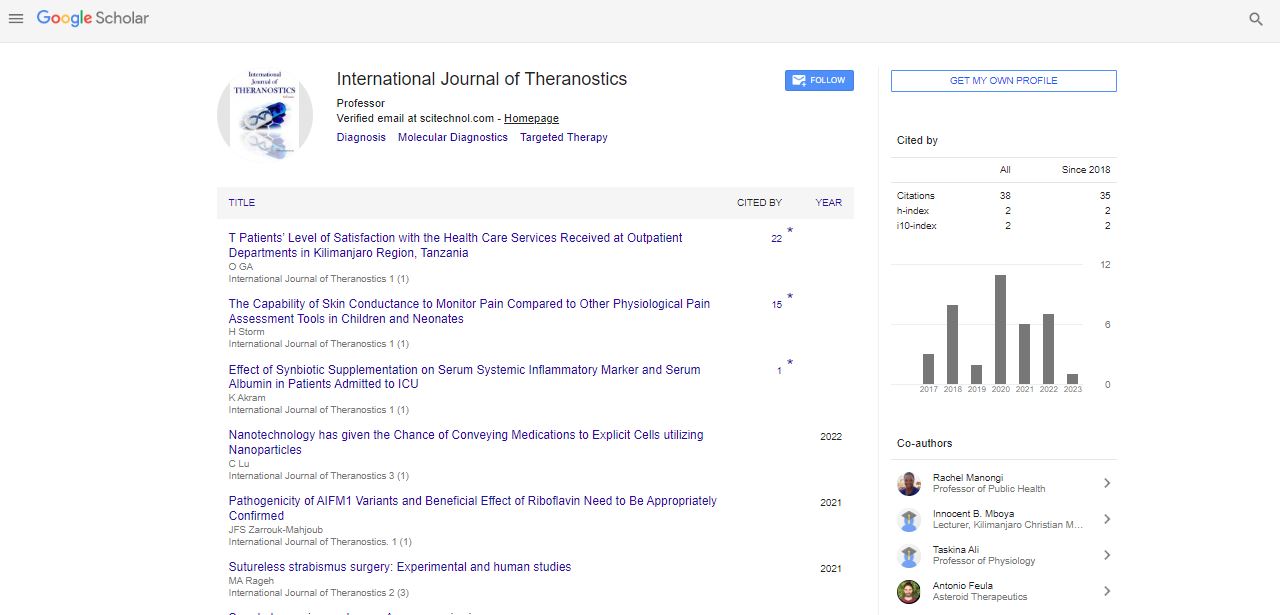Short Communication, Int J Theranostic Vol: 12 Issue: 1
Recent Advances in Nanotheranostics and its Applications
Purnachandra Nagaraju*
1Department of Hematology and Medical Oncology, Emory University, Atlanta GA, USA
*Corresponding Author: Purnachandra Nagaraju
Department of Hematology and
Medical Oncology, Emory University, Atlanta GA, USA;
E-mail: purnachandra_Naga@raju.edu
Received date: 20 February, 2023, Manuscript No. IJT-23-93143;
Editor assigned date: 23 February, 2023, Pre QC No. IJT-23-93143 (PQ);
Reviewed date: 09 March, 2023, QC No. IJT-23-93143;
Revised date: 16 March, 2023, Manuscript No: IJT-23-93143 (R);
Published date: 23 March 2023, DOI: 10.4172/Ijt.1000119.
Citation: Nagaraju P (2023) Recent Advances in Nanotheranostics and its Applications. Int J Theranostic 12:1.
Description
Nanotheranostics is an innovative field of medicine that combines both diagnostic and therapeutic functions in a single nanoscale platform. This technology offers the ability to localize diagnostic and therapeutic agents in specific sites of diseases, reducing undesired side effects, and improving the precision and effectiveness of treatment. The therapeutic and diagnostic agents are formulated in nanomedicine as a single theranostic platform, which can then be further conjugated for targeted delivery of precise medicines. Nanotheranostics has various potential applications in the diagnosis and treatment of a wide range of diseases such as cancer, cardiovascular disease, and neurodegenerative diseases. This technology has the potential to revolutionize the field of precision medicine and improve patient outcomes [1,2].
Nanotheranostics is an emerging field of medicine that combines both diagnostic and therapeutic functions in a single nanoscale platform. It aims to improve the precision and effectiveness of treatment by delivering drugs or other therapeutic agents directly to the site of the disease [3,4].
Nanotheranostics has many potential applications in the field of precision medicine. One of its major applications is in cancer treatment. Nanoparticles can be used to deliver chemotherapy drugs directly to cancer cells, increasing their effectiveness and reducing side effects. They can also be used for imaging purposes, to detect tumors earlier and more accurately [7].
Another application of nanotheranostics is in cardiovascular disease. Nanoparticles can be used to target plaque buildup in arteries, reducing the risk of heart attacks and strokes. They can also be used to deliver drugs that reduce inflammation, which is a major contributor to heart disease [8].
Nanotheranostics can also be used in neurodegenerative diseases such as Alzheimer's and Parkinson's. Nanoparticles can be used to deliver drugs that target the underlying causes of these diseases, such as amyloid beta plaques in Alzheimer's. They can also be used for imaging purposes, to detect changes in the brain earlier and more accurately [9].
One of the major advantages of nanotheranostics is its ability to deliver drugs directly to the site of the disease. This reduces the amount of drug required and reduces side effects. Nanoparticles can also be engineered to target specific cells or tissues, increasing their effectiveness.
Another advantage of nanotheranostics is its ability to combine both diagnostic and therapeutic functions in a single platform. This allows for earlier detection and more accurate diagnosis, leading to earlier treatment and better outcomes.
Despite its potential, nanotheranostics faces many challenges. One of the major challenges is the need for more research into the safety and toxicity of nanoparticles. Another challenge is the difficulty in scaling up production of nanoparticles for clinical use [10].
Future directions for nanotheranostics include the development of more targeted and efficient nanoparticles, as well as the use of artificial intelligence and machine learning to improve diagnosis and treatment. There is also potential for the use of nanotheranostics in personalized medicine, tailoring treatment to the individual patient based on their specific disease and genetic makeup.
Nanotheranostics is an innovative approach to precision medicine with many potential applications in the diagnosis and treatment of various diseases. Despite many challenges, continued research and development will lead to more effective and targeted treatments for patients.
References
- Thakor AS, Gambhir SS (2013) Nanooncology: the future of cancer diagnosis and therapy. CA Cancer J Clin 2013;63(6):395-418.
[Crossref] [Google Scholar] [Pubmed]
- Greene MK, Johnston MC, Scott CJ (2021) Nanomedicine in pancreatic cancer: current status and future opportunities for overcoming therapy resistance. Cancers 13(24):6175.
[Crossref] [Google Scholar] [Pubmed]
- Ceci C, Lacal PM, Graziani G (2022) Antibody-drug conjugates: Resurgent anticancer agents with multi-targeted therapeutic potential. Pharmacol Ther 13(24): 75-78.
[Crossref] [Google Scholar] [Pubmed]
- Damiano MG, Mutharasan RK, Tripathy S, McMahon KM, Thaxton CS (2013) Templated high density lipoprotein nanoparticles as potential therapies and for molecular delivery. Adv Drug Deliv Rev 65(5):649-662.
[Crossref] [Google Scholar] [Pubmed]
- Choi IK, Strauss R, Richter M, Yun CO (2013) Strategies to increase drug penetration in solid tumors. Front Oncol 3:193.
[Crossref] [Google Scholar] [Pubmed]
- Yan H, Endo Y, Shen Y, Rotstein D, Dokmanovic M, et al (2016) Ado-trastuzumab emtansine targets hepatocytes via human epidermal growth factor receptor 2 to induce hepatotoxicityT-DM1 induces hepatotoxicity. Mol Cancer Ther 15(3):480-490.
[Google Scholar] [Pubmed]
- Dadwal A, Baldi A, Kumar Narang R (2018) Nanoparticles as carriers for drug delivery in cancer. Artif Cells Nanomed Biotechnol 46:295-305.
[Crossref] [Google Scholar] [Pubmed]
- Frickenstein AN, Hagood JM, Britten CN, Abbott BS (2021) Mesoporous silica nanoparticles: Properties and strategies for enhancing clinical effect. Pharmaceutics 13(4):570.
[Crossref] [Google Scholar] [Pubmed]
- Zuazu-Jausoro I, Borrell M, Urrutia T, Oliver A, Montserrat I (1990) Detection of thrombin-antithrombin complexes in hypercoagulability conditions. Sangre 35(5):375-379.
[Crossref] [Google Scholar] [Pubmed]
- Hostetler MJ, Wingate JE, Zhong CJ, Harris JE, Vachet RW (1998) Alkanethiolate gold cluster molecules with core diameters from 1.5 to 5.2 nm: core and monolayer properties as a function of core size. Langmuir 14(1):17-30.
 Spanish
Spanish  Chinese
Chinese  Russian
Russian  German
German  French
French  Japanese
Japanese  Portuguese
Portuguese  Hindi
Hindi 